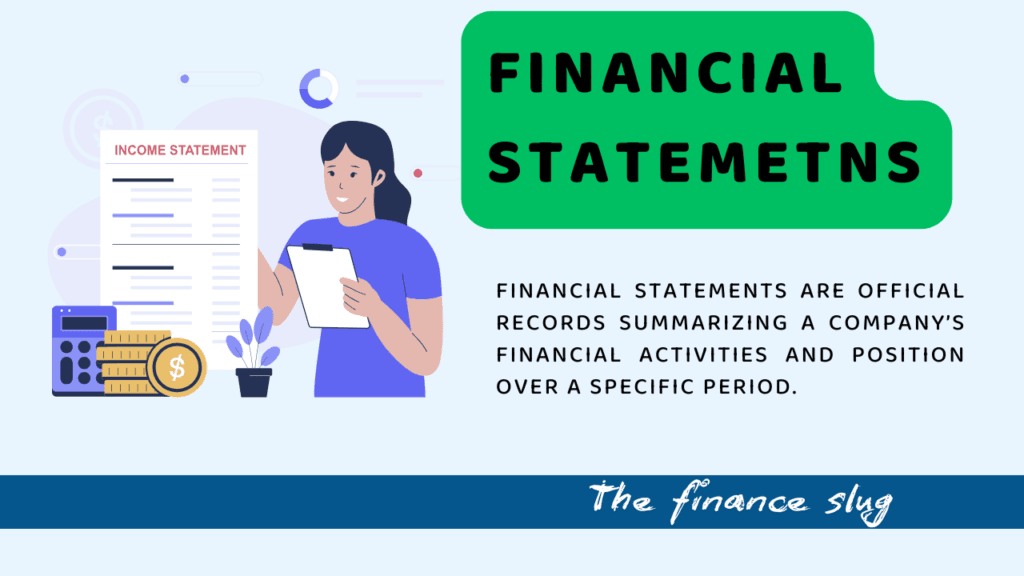
Think of financial statements as a company’s report card. They tell the story of how well (or poorly) a business is doing. Whether you’re a business owner, an investor, or just someone curious about finance, learning about financial statements is like unlocking a secret code that helps you understand a company’s financial health.
What Are Financial Statements?
Financial statements are official records summarizing a company’s financial activities and position over a specific period. These documents serve as a standardized way for businesses to communicate their financial performance to stakeholders. Understanding financial statements to make informed credit decisions, managment decisions, etc
They help answer important questions like:
- How much money is the company making?
- What are its expenses?
- Does it have enough money to pay its debts?
These documents pull numbers from a company’s financial activities and turn them into clear, understandable reports. They’re vital for anyone who wants to get a clear picture of a company’s performance and future potential.
Why Should You Care About Financial Statements?
Imagine driving a car without a dashboard—you wouldn’t know how fast you’re going or if you’re running out of gas. Financial statements are like the dashboard for a company. They help businesses, investors, and lenders make informed decisions.
The Four Main Types of Financial Statements
Here are the key financial statements every company uses:
1. Income Statement
The income statement, often called the “Profit and Loss Statement,” shows how much money a company earns and spends over a specific period.
- Why It’s Important: It tells you whether the company is making a profit or a loss.
- What’s Included:
- Revenue: The money earned from selling products or services.
- Expenses: The costs of running the business, like salaries and rent.
- Net Income: What’s left after all the expenses are paid.
Example: If a bakery earned $10,000 in sales but spent $7,000 on supplies and salaries, its net income would be $3,000.
2. Balance Sheet
The balance sheet provides a snapshot of a company’s financial position at a specific point in time. It summarizes what the company owns (assets), what it owes (liabilities), and the value left for shareholders (equity).
- Why It’s Important: It shows what a company owns (assets) and owes (liabilities) and the owner’s equity.
- What’s Included:
- Assets: Things of value, like cash, equipment, or inventory.
- Liabilities: Debts or obligations, such as loans.
- Equity: What’s left for the owners after paying off liabilities.
Example: If a business owns $50,000 in assets and owes $20,000, the equity is $30,000.
3. Cash Flow Statement
The cash flow statement focuses on the inflow and outflow of cash within a business over a specific period. Unlike the income statement, it doesn’t include non-cash items like depreciation.
- Why It’s Important: It shows if the company has enough cash to cover its operations, investments, and debts.
- What’s Included:
- Operating Activities: Day-to-day business activities.
- Investing Activities: Money spent or earned from investments.
- Financing Activities: Cash raised from loans or paid out as dividends.
4. Statement of Changes in Equity
Also known as the statement of retained earnings, this document shows changes in the owners’ equity over a reporting period.
- Why It’s Important: It explains how profits, losses, or additional investments have affected the company’s worth.
Why Financial Statements Matter
Here’s why financial statements are essential:
1. Performance Evaluation
Financial statements show whether a company is profitable, using resources wisely, or spending too much. For instance, high revenue but low profits might mean expenses are out of control.
2. Better Decision-Making
Investors and lenders use financial statements to decide if they should invest or lend money. Strong financials can attract investments and loans, while weak numbers raise red flags.
3. Spotting Trends
By comparing financial statements over time, you can spot trends. Is revenue growing? Are expenses rising too fast? Recognizing these patterns can help businesses plan better.
4. Benchmarking Against Competitors
Companies compare their financials to others in the same industry to see how they stack up. This can highlight areas where they excel or need improvement.
5. Identifying Risks
Financial statements can reveal potential problems. For example, a company heavily reliant on debt might face trouble during economic downturns.
Who Uses Financial Statements?
- Investors: They want to know if the company is worth their money.
- Lenders: Banks check financials to ensure a business can repay loans.
- Business Owners: They use these documents to track performance and make better plans.
- Regulators: To ensure companies follow rules and standards.
Benefits of Accurate Financial Statements
- Transparency: Clear, truthful numbers build trust with investors and lenders.
- Informed Decisions: Helps management plan effectively and set achievable goals.
- Better Growth Strategies: With accurate data, businesses can expand confidently.
Challenges in Preparing Financial Statements
- Time-Consuming: Gathering and organizing data can take time.
- Human Errors: Mistakes in calculations or reporting can lead to wrong conclusions.
- Compliance: Following strict accounting standards requires expertise.
How to Analyze Financial Statements
1. Ratio Analysis
Ratios like profitability, liquidity, and efficiency give deeper insights into a company’s performance. For example, the debt-to-equity ratio shows how much of the company is financed through debt compared to equity.
2. Trend Analysis
By looking at financial data over time, you can identify growth patterns or potential challenges.
3. Industry Comparison
Benchmarking financial statements against competitors highlights strengths and weaknesses.
Frequently Asked Questions (FAQs)
1. What are the four main financial statements?
The income statement, balance sheet, cash flow statement, and statement of changes in equity.
2. Why are financial statements important for businesses?
They provide insights into a company’s financial health, helping with decision-making, planning, and compliance.
3. How do investors use financial statements?
Investors analyze them to decide whether a company is a good investment opportunity.
4. What’s the difference between an income statement and a balance sheet?
An income statement shows earnings and expenses over time, while a balance sheet shows the financial position at a specific point.
5. What can financial statements reveal about risks?
They can show potential problems, like high debt or declining revenue, before they become major issues.
Conclusion
Financial statements are essential tools for anyone who wants to understand a company’s financial health. They simplify complex financial data and provide insights that guide decision-making, planning, and risk management.
Whether you’re an investor, a business owner, or just someone curious about finance, understanding financial statements is a valuable skill that can help you make smarter decisions.
For more financial insights and tips, visit Financeslug.
Resources








Pingback: Financial Statements 101: Learn How to Read and Analyze Them
Pingback: The Golden Rules of Accounting: Personal, Real, and Nominal
Pingback: What Is Accounting? A Beginner’s Guide to Financial Clarity
Pingback: Accounting Concepts and Principles: A Step-by-Step Overview